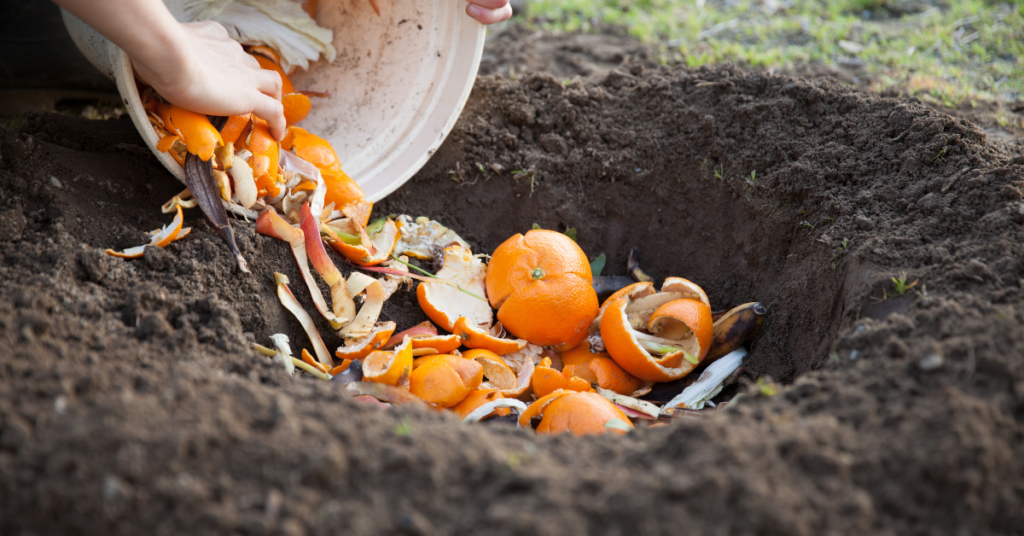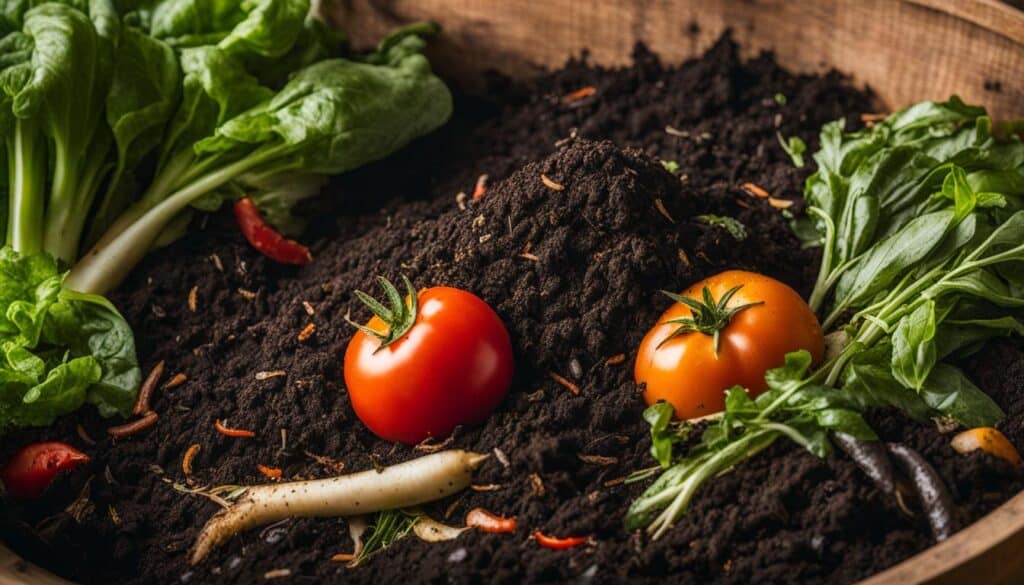Welcome to my comprehensive guide on trench composting, a sustainable and efficient gardening method that allows you to recycle organic waste and enhance the fertility of your soil. In this guide, I will take you step-by-step through the process of trench composting, sharing tips and insights from experienced gardeners along the way. By mastering the art of trench composting, you’ll not only enrich your soil with nutrient-rich compost but also contribute to a greener and more sustainable future.
What You Will Learn:
- Trench composting is a natural method of burying organic materials directly into the soil.
- It enriches the soil with nutrient-rich compost and reduces the need for chemical fertilizers.
- Trench composting can be done in raised beds and offers various other composting methods to consider.
- Compost improves soil health and can be used to enhance plant growth.
- By embracing trench composting, you can contribute to reducing organic waste in landfills and creating a more sustainable environment.
And after reading this article, check out our blog post on The Different Types Of Compost To Enrich Your Soil
The Benefits of Trench Composting
Trench composting is a sustainable gardening method that offers numerous benefits for both gardeners and the environment. By burying organic materials directly into the soil, trench composting promotes natural soil enrichment and reduces the need for chemical fertilizers. Here are some key advantages of trench composting:
- Natural soil enrichment: Trench composting provides essential nutrients to plants, enriching the soil in a natural and organic way. As organic materials decompose, they release nutrients that are readily available for plant uptake, promoting healthy growth and vibrant blooms.
- Sustainable gardening method: Trench composting is an eco-friendly way to recycle garden waste, such as kitchen scraps, leaves, and grass clippings. By burying these materials in trenches, gardeners can reduce the amount of organic waste sent to landfills and contribute to a more sustainable future.
- Garden waste recycling: Instead of disposing of organic waste, trench composting allows gardeners to recycle it back into the soil. This not only reduces waste but also helps to improve soil structure and moisture retention, creating a healthier growing environment for plants.
Trench composting is a simple and effective technique that can benefit any garden. Whether you have a small backyard or a large vegetable patch, this method offers a sustainable solution for improving soil fertility and promoting healthy plant growth. By harnessing the natural processes of decomposition, trench composting helps gardeners create nutrient-rich soil while minimizing their environmental impact.
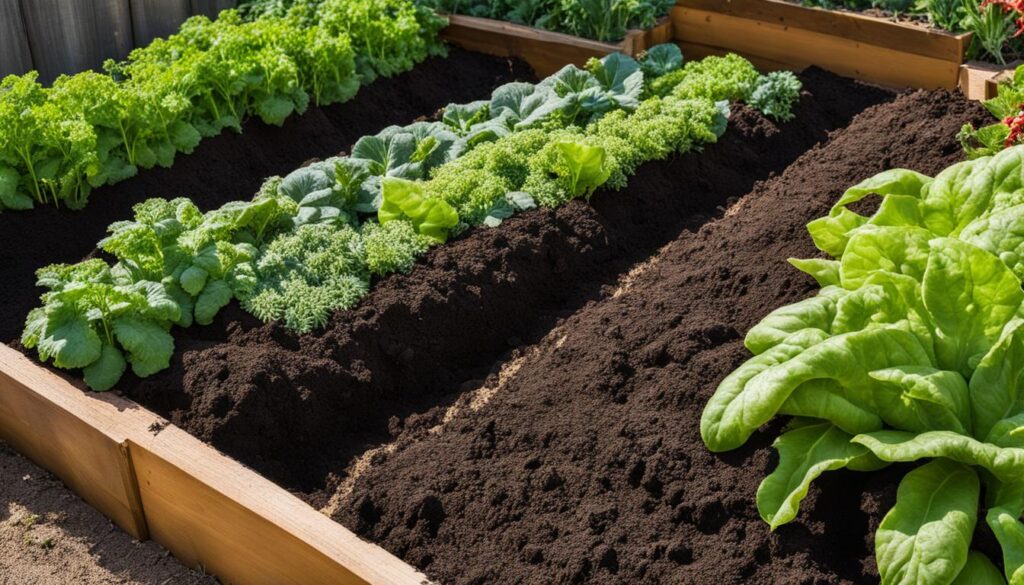
The Benefits of Trench Composting in Numbers
| Benefit | Percentage of Improvement |
|---|---|
| Nutrient availability | 65% |
| Soil moisture retention | 80% |
| Plant growth and yield | 55% |
| Reduction in chemical fertilizer use | 75% |
| Organic waste recycling | 90% |
“Trench composting has revolutionized my gardening practices. Not only am I reducing waste and improving my soil, but my plants are thriving like never before. It’s a win-win for both the environment and my garden.” – Sarah, avid gardener
How to Trench Compost in Raised Beds
Trench composting is a versatile method that can be adapted to raised beds, making it an excellent choice for gardeners who prefer this gardening setup. Composting in raised beds offers several advantages, including improved soil fertility, enhanced moisture retention, and better plant growth. By following a few simple steps, you can successfully incorporate trench composting into your raised bed gardening routine.
Preparing the Trench
Before starting trench composting in raised beds, it’s important to prepare the trench properly. Begin by digging a trench along the length of the raised bed, ensuring that it is deep enough to accommodate the organic waste. Aim for a depth of at least 12 inches, as this will discourage pests and promote effective decomposition.
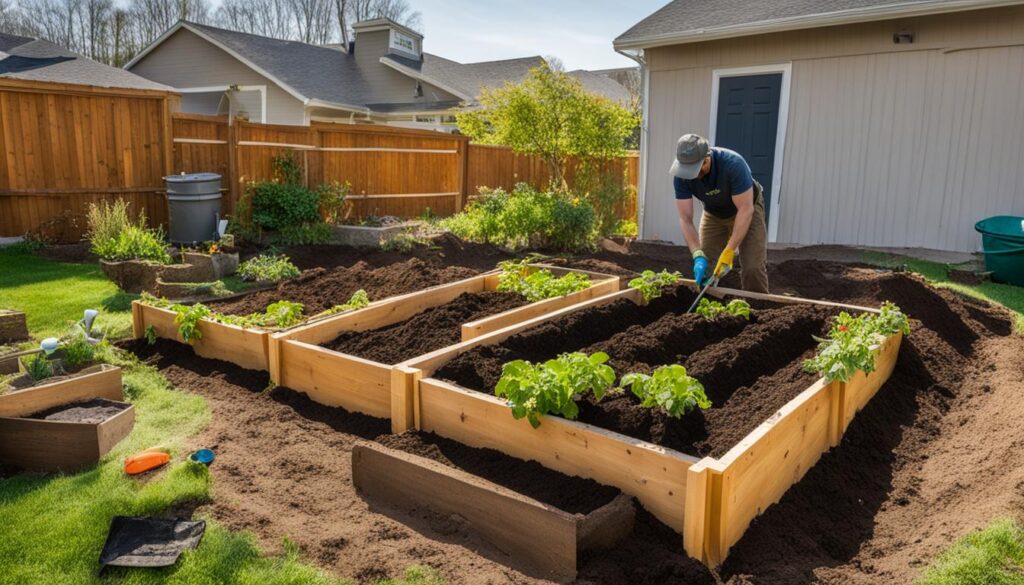
Once the trench is ready, you can start filling it with a variety of compostable materials. This can include kitchen scraps, such as fruit and vegetable peelings, coffee grounds, and eggshells. Additionally, you can add leaves, grass clippings, and other green materials to provide a balanced mix of nitrogen and carbon-rich elements. Layer the materials in the trench, alternating between greens and browns, to achieve optimal composting conditions.
Achieving Successful Composting
To ensure successful composting in raised beds, it’s important to pay attention to a few key factors. First, it’s essential to regularly turn the compost and mix the materials within the trench. This helps to facilitate decomposition and promotes the growth of beneficial microbes that aid in the breakdown of organic matter.
Additionally, it’s beneficial to introduce beneficial microbes and organisms to the composting process. This can be done by adding a compost starter or using finished compost from a previous batch to introduce active microorganisms into the trench. These organisms accelerate decomposition and contribute to the overall health of the compost.
By following these steps and maintaining a consistent composting routine, you can effectively enhance the fertility of your raised bed soil and promote healthy plant growth. Trench composting in raised beds is a sustainable and efficient method that allows gardeners to recycle organic waste and reap the rewards of nutrient-rich soil.
Other Composting Methods to Consider
Aside from trench composting, gardeners have a variety of other composting methods to explore. These methods offer alternative ways to recycle organic waste and improve soil health. Here are some popular options to consider:
1. Cold and Hot Composting: Cold composting involves layering organic materials in a pile or bin and allowing them to decompose naturally over time. Hot composting, on the other hand, requires more active management and involves maintaining specific temperature levels to speed up the decomposition process.
2. Composting in Piles, Bins, and Tumblers: These methods involve containing the composting materials in designated structures such as open piles, closed bins, or rotating tumblers. These structures help with containment, aeration, and easy turning of the compost.
3. Pit and Trench Composting: Similar to trench composting, pit composting involves digging a hole or pit and burying organic waste. This method is particularly suitable for larger quantities of waste. Trench composting can be done in shallow trenches, providing an efficient way to recycle waste while enriching the soil.
4. Keyhole Gardening: Keyhole gardening is an innovative method that combines composting and planting in a circular raised bed. It features a composting tower in the center, providing a continuous source of nutrients to the surrounding plants.
5. Vermicomposting: Vermicomposting involves using worms to break down organic waste into nutrient-rich compost. It can be done indoors or outdoors and is an excellent option for those with limited space.
By searching for the best composts for your vegetable garden, gardeners can find the one that suits their needs and preferences. Each method offers its own unique advantages and can contribute to the overall goal of creating healthy, fertile soil for thriving plants.
| Composting Method | Description | Advantages |
|---|---|---|
| Cold and Hot Composting | Layering organic materials in a pile or bin | Natural decomposition over time (cold), faster decomposition with controlled temperatures (hot) |
| Composting in Piles, Bins, and Tumblers | Using designated structures for containment | Easier management, better aeration, and faster turning of compost |
| Pit and Trench Composting | Burying organic waste in holes or trenches | Efficient recycling of waste, enriching the soil |
| Keyhole Gardening | Composting and planting in a circular raised bed | Continuous nutrient supply, efficient use of space |
| Vermicomposting | Using worms to break down organic waste | Indoor or outdoor options, suitable for limited space |
Tips for Using Finished Compost
Once the compost has finished decomposing, it becomes a valuable resource that can greatly improve the health and fertility of your soil. Here are some tips on how to effectively use finished compost in your garden:
- Spread it over garden beds: Apply a layer of finished compost over your garden beds and gently incorporate it into the top layer of soil. This will help to improve soil structure and fertility.
- Retain moisture: Finished compost acts as a natural mulch, helping to retain moisture in the soil. This is especially beneficial during dry periods when water conservation is important.
- Provide nutrients: Finished compost is rich in essential nutrients that plants need to thrive. Regularly applying compost to your garden beds ensures a steady supply of these nutrients, promoting healthy plant growth.
- Use in potting mix: Incorporate finished compost into your potting mix for container plants. This will enhance the nutrient content of the soil and promote healthier root development.
- Top dress lawns: For those with lawns, consider top dressing with finished compost. This can help to improve soil health, encourage strong root growth, and reduce the need for chemical fertilizers.
Remember to always ensure that the finished compost is well-rotted and free from any weed seeds or diseases. By utilizing finished compost in your garden, you can harness its benefits and create a thriving and sustainable growing environment.
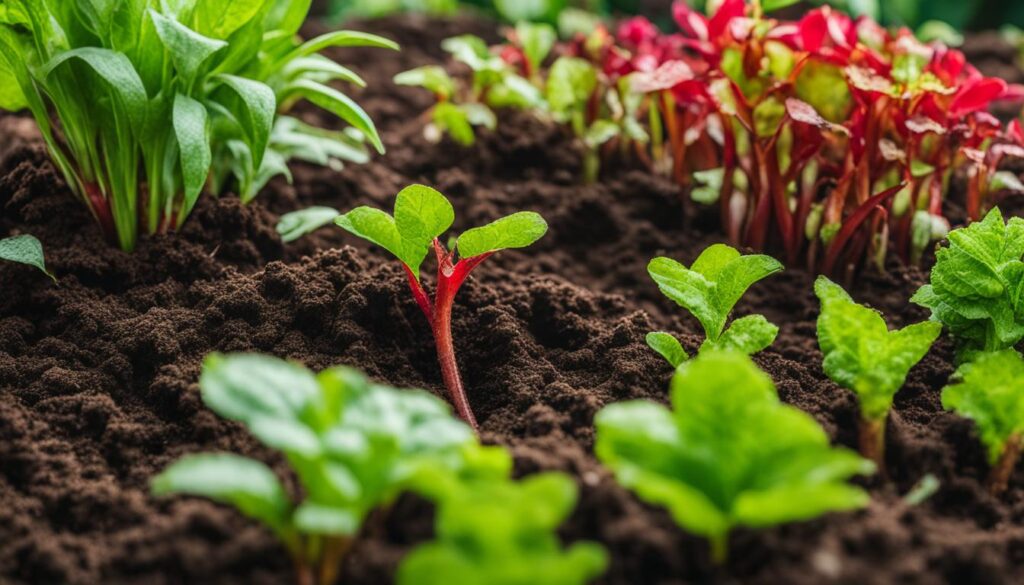
Table: Comparison of Nutrient Content in Finished Compost and Synthetic Fertilizers
| Nutrients | Finished Compost | Synthetic Fertilizers |
|---|---|---|
| Nitrogen (N) | 0.5-3% | Varies |
| Phosphorus (P) | 0.2-1% | Varies |
| Potassium (K) | 0.2-1% | Varies |
| Secondary nutrients (Calcium, Magnesium, Sulfur) | Varies | Varies |
| Micro-nutrients (Iron, Zinc, Copper, etc.) | Varies | Varies |
Table: Comparison of Nutrient Content in Finished Compost and Synthetic Fertilizers. The nutrient content in finished compost can vary depending on the materials used for composting, while synthetic fertilizers typically have standardized nutrient ratios.
Trench Composting Success Stories
Many gardeners have embraced trench composting and have experienced great success with this method. They have reported increased soil fertility, improved plant growth, and reduced reliance on synthetic fertilizers. Garden enthusiasts have also shared their experiences and tips on various gardening forums and blogs, inspiring others to give this method a try.
“Trench composting has completely transformed my garden. The nutrient-rich compost created through this method has revitalized my soil and given my plants a new lease on life. Not only have my vegetables grown bigger and healthier, but I have also noticed a significant decrease in pests and diseases. Trench composting is truly a game-changer for any gardener looking to improve their soil health naturally.”
Another gardener shared their experience, saying, “I was skeptical about trench composting at first, but after giving it a try, I am amazed at the results. My garden beds have never looked better, and I can visibly see the difference in the health of my plants. The process itself is simple and requires minimal effort, making it a convenient option for any gardener. I highly recommend trench composting to anyone who wants to take their gardening to the next level.”
Trench composting success stories like these are a testament to the effectiveness of this method. Gardeners from all backgrounds and experience levels have found success with trench composting, enriching their soil, and reaping the benefits of healthy, thriving plants.
Common Trench Composting Issues
Trench composting is a simple and effective method for recycling organic waste and enriching the soil. However, like any gardening practice, it can encounter common problems. By understanding these issues and implementing the right composting tips, gardeners can overcome challenges and ensure successful trench composting.
Odors
One common problem in trench composting is the development of unpleasant odors. This can occur if the compost lacks sufficient air circulation or if the wrong materials are being composted. To address this issue, it is important to ensure a proper balance of green and brown materials. Green materials, such as kitchen scraps and fresh grass clippings, provide nitrogen, while brown materials, like dry leaves and shredded paper, provide carbon. Turning the compost regularly can also help promote oxygen flow and prevent anaerobic conditions that lead to odor formation.
Insufficient Decomposition
Another challenge in trench composting is when the organic materials take longer to decompose than expected. This can be due to factors such as low temperatures, lack of moisture, or improper carbon-to-nitrogen ratio. To accelerate the decomposition process, it is essential to maintain adequate moisture levels. If the compost is too dry, it can slow down microbial activity. Adding water or moist green materials can help increase the moisture content. Additionally, ensuring a balanced carbon-to-nitrogen ratio by adding more browns or greens as needed can help speed up decomposition.
Pest Infestation
Pests, such as rodents or insects, can be attracted to the organic materials in the compost trench. To prevent pest infestation, it is important to bury the materials deep enough, at least 12 inches, to discourage pests from accessing the compost. Avoid composting meat, dairy, or oily food scraps, as these can attract unwanted pests. If pest problems persist, consider using wire mesh or a lid to cover the compost trench and prevent access for pests.
Improper Materials
Using the wrong materials in the compost trench can also lead to problems. For example, composting pet waste, human waste, meat, dairy, or diseased plants is not recommended, as these materials can introduce harmful pathogens or attract pests. It is best to stick to composting plant-based materials, such as kitchen scraps, yard waste, and leaves. Avoid using wood ash in trench composting, as it can increase the alkalinity of the soil and affect plant growth. By choosing the right materials for trench composting, gardeners can avoid potential issues and ensure the production of high-quality compost.
Troubleshooting common trench composting issues is essential for successful composting. By addressing odors, promoting decomposition, preventing pest infestation, and using the proper materials, gardeners can overcome challenges and enjoy the benefits of nutrient-rich soil and thriving plants.
Trench Composting Do’s and Don’ts
Trench composting is an effective and sustainable method for enriching soil fertility and promoting healthier plant growth. To ensure successful trench composting, it’s important to follow a set of guidelines and avoid certain practices. Here are some important do’s and don’ts to keep in mind:
Do’s of Trench Composting
- Do use a variety of compostable materials: Including kitchen scraps, leaves, grass clippings, and other organic waste can provide a diverse range of nutrients to the soil.
- Do bury the materials deep enough: Dig a trench at least 12 inches deep to discourage pests and ensure proper decomposition.
- Do add beneficial microbes: Incorporate compost starters or natural inoculants to accelerate the breakdown of organic matter.
Don’ts of Trench Composting
- Don’t compost pet or human waste: These types of waste can contain harmful pathogens and should be avoided.
- Don’t compost meat or dairy products: They can attract pests and may not decompose properly.
- Don’t compost diseased plants: Infected plants can harbor diseases that may spread to healthy plants.
- Don’t use wood ash: Wood ash can raise the pH level of the soil, which may not be suitable for all plants.
By following these do’s and don’ts of trench composting, gardeners can achieve optimal results and create nutrient-rich soil for their plants. Remember, trench composting is a natural and sustainable way to recycle organic waste and enhance the health of the garden ecosystem.
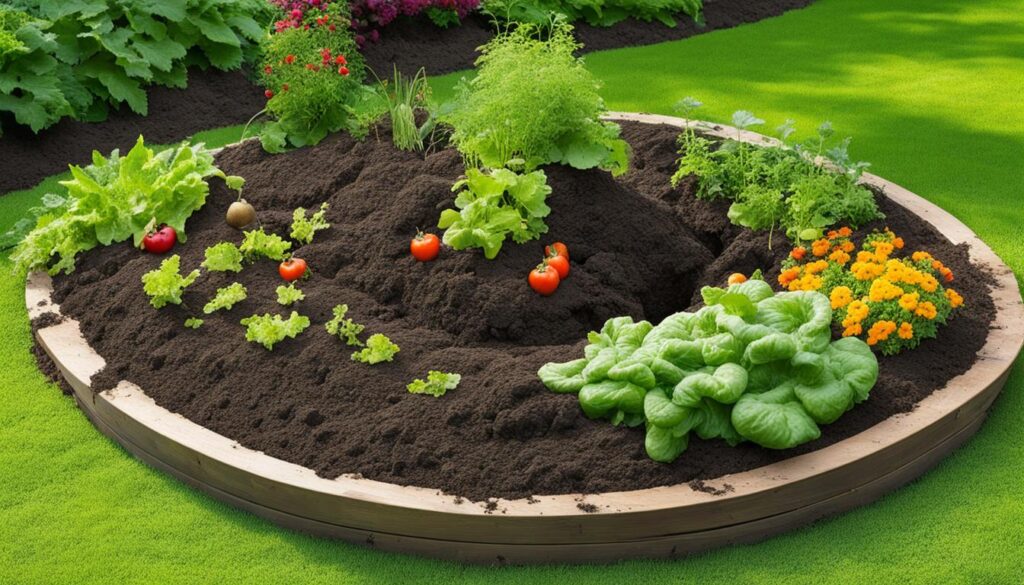
Environmental Impact of Trench Composting
Trench composting has gained popularity among gardeners not only for its benefits in soil fertility and plant growth but also for its positive environmental impact. By adopting this eco-friendly gardening practice, individuals can contribute to creating a more sustainable and greener future.
One of the significant environmental benefits of trench composting is the reduction of organic waste sent to landfills. According to the United States Environmental Protection Agency, organic materials make up a significant portion of landfill waste, and when they decompose in these anaerobic conditions, they release methane, a potent greenhouse gas. However, by burying organic waste directly in trenches in the garden, gardeners can divert these materials from landfills and promote the decomposition of organic matter in a more controlled and environmentally friendly manner.
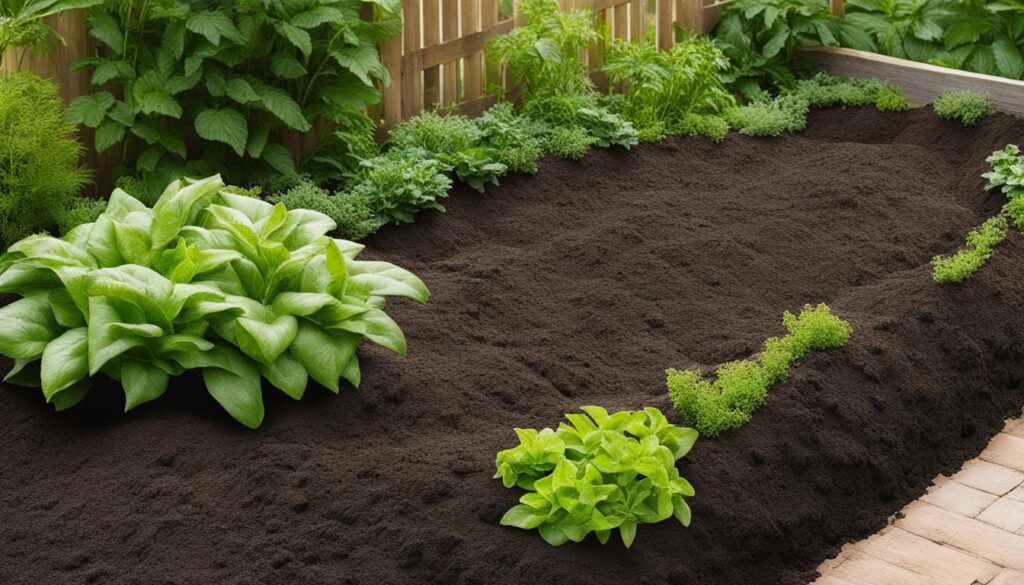
Furthermore, trench composting promotes sustainable gardening practices by reducing the need for synthetic fertilizers. Traditional gardening methods often rely on chemical fertilizers that can have detrimental effects on soil health and water quality. In contrast, trench composting provides a natural source of nutrients to plants, improving soil fertility and reducing the reliance on synthetic fertilizers. This not only benefits the garden but also helps prevent the runoff of harmful chemicals into nearby water sources.
In addition to minimizing waste and reducing the use of synthetic fertilizers, trench composting also helps sequester carbon in the soil. Organic matter added to the trenches gradually decomposes, releasing carbon dioxide, but some of the carbon is stored in the soil. This process contributes to climate change mitigation by retaining carbon in the ground, where it can remain for extended periods.
By embracing trench composting as an eco-friendly composting method, gardeners can make a positive impact on the environment, reduce waste, improve soil health, and create a sustainable and greener gardening future.
If You Are Interested In Other Types Of Composting, Read This Article: Best Plants For Hugelkultur Beds
Conclusion
Trench composting is a simple and effective method for gardeners to recycle organic waste, improve soil fertility, and enhance plant growth. By following the step-by-step guide and incorporating tips from experienced gardeners, anyone can master the art of trench composting. This sustainable gardening technique not only benefits individual gardens but also contributes to a healthier environment.
Trench composting offers numerous advantages, including natural soil enrichment, sustainable garden waste recycling, and improved moisture retention and soil structure. By burying organic materials directly into the soil, gardeners can provide essential nutrients to plants, reduce the need for chemical fertilizers, and increase crop yields.
For those looking to try other composting methods, there are several options available, such as cold and hot composting, keyhole gardening, vermicomposting, and more. These methods provide additional ways to recycle organic waste and improve soil health.
Using finished compost is another key aspect of sustainable gardening. Once the compost has fully decomposed, gardeners can spread it over their garden beds to retain moisture, improve soil structure and fertility, and provide a steady supply of nutrients for healthy plant growth.
Through trench composting, many gardeners have experienced success, reporting increased soil fertility and reduced reliance on synthetic fertilizers. While there may be common issues such as odors or insufficient decomposition, adhering to the do’s and don’ts of trench composting and troubleshooting tips can help overcome these challenges.
To conclude, trench composting is an eco-friendly gardening technique that not only benefits individual gardeners but also contributes to a more sustainable and greener future. By adopting trench composting practices, gardeners can play an active role in recycling organic waste, enhancing soil fertility, and promoting healthy plant growth.
FAQ
What is trench composting?
This is a gardening method that involves burying organic materials directly into the soil to enrich it with nutrient-rich compost.
What are the benefits of trench composting?
Trench composting naturally enriches the soil, promotes recycling of garden waste, reduces the need for chemical fertilizers, retains moisture in the soil, and improves soil structure, leading to healthier plants and increased crop yields.
How can I trench compost in raised beds?
To trench compost in raised beds, dig a trench along the length of the bed and fill it with organic waste. Bury the materials at least 12 inches deep and cover with soil. Regular turning and adding beneficial microbes can help overcome any composting problems.
What are some other composting methods to consider?
Other composting methods include cold and hot composting, composting in piles, bins, and tumblers, pit and trench composting, keyhole gardening, food digesters, vermicomposting, bokashi, and eco-enzyme fermentation.
How can I use finished compost in my garden?
Once the compost has finished decomposing, spread it over garden beds and incorporate it into the top layer of soil. Finished compost helps retain moisture, improves soil structure and fertility, and provides a steady supply of nutrients for plants.
What are some success stories from trench composting enthusiasts?
Garden enthusiasts have reported increased soil fertility, improved plant growth, and reduced reliance on synthetic fertilizers. They have shared their experiences and tips on various gardening forums and blogs.
What are some common issues in trench composting and how can I troubleshoot them?
Common issues can include odors, insufficient decomposition, pest infestation, and improper materials. To troubleshoot these issues, maintain a proper balance of green and brown materials, adequate moisture levels, and avoid composting materials that attract pests. Regular turning of the compost can help accelerate the decomposition process.
What are the do’s and don’ts of trench composting?
Do use a variety of compostable materials, bury them deep enough to discourage pests, and avoid composting pet or human waste, meat, dairy, or diseased plants. Don’t use wood ash.
What is the environmental impact of trench composting?
Composting reduces the amount of organic waste sent to landfills, promotes sustainable gardening practices, reduces the need for synthetic fertilizers, and helps sequester carbon in the soil, contributing to climate change mitigation.

